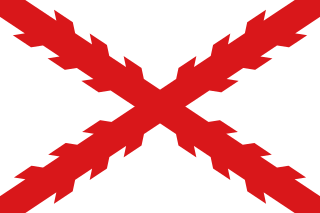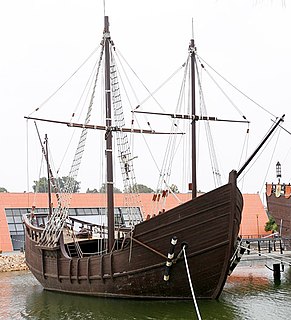 W
WChristopher Columbus was an Italian explorer and navigator who completed four voyages across the Atlantic Ocean, opening the way for European exploration and colonization of the Americas. His expeditions, sponsored by the Catholic Monarchs of Spain, were the first European contact with the Caribbean, Central America, and South America.
 W
WBetween 1492 and 1504, Italian explorer Christopher Columbus led four Spanish-based transatlantic maritime expeditions to the Americas, a continental landmass which was virtually unknown to and outside of the Old World (Afro-Eurasia). These voyages to America led to the widespread knowledge of its existence. This breakthrough inaugurated the period known as the Age of Discovery, which saw the colonization of the Americas, a related biological exchange, and trans-Atlantic trade. These events, the effects and consequences of which persist to the present, are sometimes cited as the beginning of the modern era.
 W
W1493: Uncovering the New World Columbus Created is a nonfiction book by Charles C. Mann first published in 2011. It covers the global effects of the Columbian Exchange, following Columbus' first landing in the Americas, that led to our current globalized world civilization. It follows on from Mann's previous book on the Americas prior to Columbus, 1491: New Revelations of the Americas Before Columbus.
 W
WThe Capitulations of Santa Fe between Christopher Columbus and the Catholic Monarchs, Queen Isabella I of Castile and King Ferdinand II of Aragon, were signed in Santa Fe, Granada on April 17, 1492. They granted Columbus the titles of admiral of the Ocean Sea, viceroy, and governor-general and the honorific don, and also the tenth part of all riches to be obtained from his intended voyage. The document followed a standard form in 15th-century Castile with specific points arranged in chapters (capítulos). Although not a formal agreement, the capitulations resulted from negotiation.
 W
WThe Christopher Columbus House in Genoa is an 18th-century reconstruction of the house in which Christopher Columbus grew up.
 W
WThe Columbian Viceroyalty, Viceroyalty of India or First Viceroyalty in the Indies is the name that designates the number of titles and rights granted to Christopher Columbus by the Catholic Monarchs in 1492 on the lands discovered and undiscovered, before embarking on his first trip that culminated in the discovery of the Americas.
 W
WThe Columbus Citizens Foundation is a non-profit organization in New York City committed to fostering an appreciation of Italian-American heritage and achievement. The Foundation, through a range of philanthropic and cultural activities, provides opportunities for advancement to Italian-American students through various scholarship and grant programs. The Foundation organizes New York City's annual Columbus Celebration and Columbus Day Parade, which has celebrated Italian-American heritage on New York's Fifth Avenue since 1929.
 W
WColumbus Day is a national holiday in many countries of the Americas and elsewhere which officially celebrates the anniversary of Christopher Columbus's arrival in the Americas on October 12, 1492. Christopher Columbus first landed in what is now Luperón, a small town on the north coast of the Dominican Republic side of the island of Hispaniola. The name of Hipañola was given to the island to honor the queen Isabel of Spain. Christopher Columbus was an Italian-Genoa explorer on behalf of Spain, who set sail from "Puerto de Palos, Spain to across the Atlantic Ocean in search of a faster route to the Far East only to land at the New World. His first voyage to the New World on the Spanish ships Santa María, Niña, and La Pinta took approximately three months. Columbus and his crew's arrival to the New World initiated the Columbian Exchange which introduced the transfer of plants, animals, culture, human populations, and technology between the New World and the Old World.
 W
WAn egg of Columbus or Columbus' egg refers to a brilliant idea or discovery that seems simple or easy after the fact. The expression refers to an apocryphal story, dating from at least the 15th century, in which it is said that Christopher Columbus, having been told that finding a new trade route was inevitable and no great accomplishment, challenges his critics to make an egg stand on its tip. After his challengers give up, Columbus does it himself by tapping the egg on the table to flatten its tip.
 W
WThe Fontanilla is the former public fountain of Palos de la Frontera in Spain where, according to tradition, these fountains provided the water for the ships of Christopher Columbus's first voyage—the Santa María, the Niña, and the Pinta—when, on 3 August 1492, they departed from Palos de la Frontera, captained by Columbus and by Palos's own Pinzón Brothers upon the voyage widely considered to have led the "discovery" of what historians term the "New World".
 W
WRodrigo de Jerez was one of the Spanish crewmen who sailed to the Americas on the Santa Maria as part of Christopher Columbus's first voyage across the Atlantic Ocean in 1492. He was born in Ayamonte, a small city in the southwest of Spain. He is credited with being the first European smoker.
 W
WThe Lugares colombinos is a tourist route in the Spanish province Huelva, which includes several places that have special relevance to the preparation and realization of the first voyage of Cristopher Columbus. That voyage is widely considered to constitute the discovery of the Americas by Europeans. It was declared a conjunto histórico artístico by a Spanish law of 1967.
 W
WA total lunar eclipse occurred on 1 March 1504, visible at sunset for the Americas, and later over night over Europe and Africa, and near sunrise over Asia.
 W
WLa Niña was one of the three Spanish ships used by Genoan explorer Christopher Columbus in his first voyage to the West Indies in 1492. As was tradition for Spanish ships of the day, she bore a female saint's name, Santa Clara. However, she was commonly referred to by her nickname, La Niña, which was probably a pun on the name of her owner, Juan Niño of Moguer. She was a standard caravel-type vessel.
 W
WThe exact ethnic or national origin of Christopher Columbus (1451-1506) has been a source of speculation since the 19th century. The general consensus among historians is that Columbus' family was from the coastal region of Liguria, that he spent his boyhood and early youth in the Republic of Genoa, in Genoa, in Vico Diritto, and that he subsequently lived in Savona, where his father Domenico moved in 1470. Much of this evidence derives from data concerning Columbus's immediate family connections in Genoa and opinions voiced by contemporaries concerning his Genoese origins, which few dispute.
 W
WLa Pinta was the fastest of the three ships used by Christopher Columbus in his first transatlantic voyage in 1492. The New World was first sighted by Rodrigo de Triana aboard La Pinta on 12 October 1492. The owner of La Pinta was Cristóbal Quintero. The Quintero brothers were ship owners from Palos. The owner of the ship allowed Martín Alonso Pinzón to take over the ship so he could keep an eye on the ship.
 W
WThe Pinzón brothers were Spanish sailors, pirates, explorers and fishermen, natives of Palos de la Frontera, Huelva, Spain. Martín Alonso, Francisco Martín and Vicente Yáñez, participated in Christopher Columbus's first expedition to the New World and in other voyages of discovery and exploration in the late 15th and early 16th centuries.
 W
WMartín Alonso Pinzón, was a Spanish mariner, shipbuilder, navigator and explorer, oldest of the Pinzón brothers. He sailed with Christopher Columbus on his first voyage to the New World in 1492, as captain of the Pinta. His youngest brother Vicente Yáñez Pinzón was captain of the Niña, and the middle brother Francisco Martín Pinzón was maestre of the Pinta.
 W
WHans Pothorst was a privateer, likely from the German city Hildesheim. He is mostly notable because some have proposed that he may have discovered America along with Didrik Pining in the 1470s, almost twenty years before Columbus.
 W
WLa Santa María, alternatively La Gallega, was the largest of the three ships used by Christopher Columbus in his first voyage across the Atlantic Ocean in 1492, the others being the Niña and the Pinta. Her master and owner was Juan de la Cosa, a man from Santoña, Cantabria, operating in south Spanish waters. Requisitioned by order of Queen Isabella and by contract with Christopher Columbus, whom de la Cosa knew previously, the Santa Maria became Columbus' flagship on the voyage as long as it was afloat. Having gone aground on Christmas Day, 1492, on the shores of Haiti, through inexperience of the helmsman, it was partially dismantled to obtain timbers for Fort Navidad, "Christmas Fort," placed in a native Taíno village. The fort was the first Spanish settlement in the New World, which Columbus had claimed for Spain. He thus regarded the wreck as providential. The hull remained where it was, the subject of much modern wreck-hunting without successful conclusion.
 W
WLuis de Santángel was a third generation converso in Spain during the late fifteenth century. Santángel worked as escribano de racion to King Ferdinand II and Queen Isabella I of Spain which left him in charge of the Royal finance. Santángel played an instrumental role in Christopher Columbus's voyage in 1492, for he managed to convince the Catholic monarchs to fund Columbus's expedition and provided a large sum of the money himself.
 W
WRodrigo de Triana was a Spanish sailor, believed to be the first European since Leif Ericson to have seen the Americas. Born as Juan Rodríguez Bermejo, Triana was the son of hidalgo and potter Vicente Bermejo and Sereni Betancour.